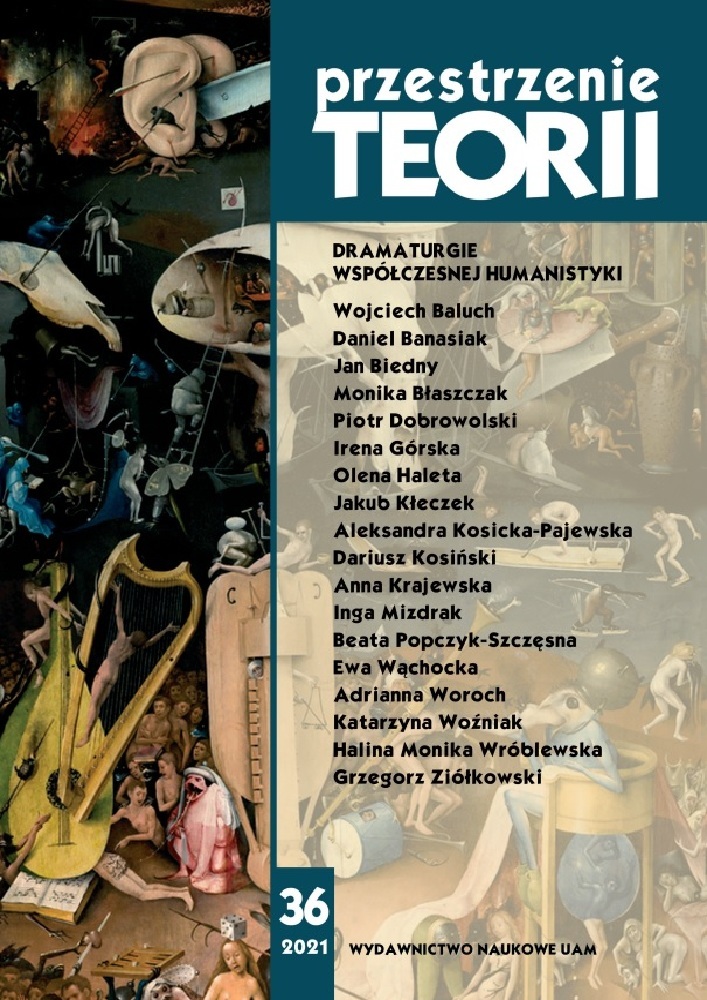Abstract
This article is an attempt to investigate contemporary film theory highlighting the inseparable connection between cinema and the human body and seeing, in which sense this theory complements academic recognition about neomodernism. The author expands on the philosophical concept of experience, showing problems posed by its conceptualization, and also points to the connection of this term with the body and sensuality. In the next part, the main distinguishing features characterizing the dramaturgy of cinematic neomodernism are given. The author argues that the dramaturgy of this movement creates a different kind of cinema experience in general. The final part presents an analysis of two films which are examples of the theory of cinema as senses, as well as exemplifying the dramaturgy characteristic for neomodernism, and thus creating a specific type of experience in the viewer.
References
Doświadczenie, red. T. Buksiński, Poznań 2001.
Dramaturg w teatrze, literaturze, sztuce. Dramaturgia – nowe horyzonty, red. W. Baluch, A. Krajewska, Poznań 2019.
Dudley A., The Major Film Theories, Nowy Jork 1976.
Elsaesser T., Hagener M., Teoria filmu: Wprowadzenie przez zmysły, przeł. K. Wojnowski, Kraków 2015.
Gendlin T.E., Experiencing and the Creation of Meaning. A Philosophical and Psychological Approach to the Subjective, Evanston 1997.
Helman A., Ostaszewski J., Historia myśli filmowej, Kraków 2007.
Hendrykowski M., Słownik terminów filmowych, Poznań 1994.
Jay M., Pieśni doświadczenia. Nowoczesne amerykańskie i europejskie wariacje na uniwersalny temat, przeł. A. Rejniak-Majewska, Kraków 2008.
Kino: gest – ciało – ruch. Film w perspektywie systemów komunikowania niewerbalnego, red. A. Gwóźdź, Wrocław 1990.
Kosiński D., Performatyka. W(y)prowadzenia, Kraków 2016.
Oakeshott M., Experience and Its Modes, Cambridge 1995.
Ostaszewski J., Film i poznanie. Wprowadzenie do kognitywnej teorii filmu, Kraków 1999.
Ostaszewski J., Oddramatyzowanie akcji i antyklimaks w kinie współczesnym, „Panoptikum” 2018, nr 19(26), s. 80–94.
Sauerland K., Od Diltheya do Adorna. Studia z estetyki niemieckiej, Warszawa 1986.
Sobchack V., The Address of the Eye. A Phenomenology of Film Experience, Princeton 1992.
Syska R., Filmowy modernizm, „Kwartalnik Filmowy” 2009, 67/68.
Syska R., Filmowy neomodernizm, Kraków 2014.
License
Authors
Authors of texts accepted for publication in Przestrzenie Teorii are required to complete, sign and return to the editor's office the Agreement for granting a royalty-free license to works with a commitment to grant a CC sub-license.
Under the agreement, the authors of texts published in Przestrzenie Teorii grant the Adam Mickiewicz University in Poznań a non-exclusive, royalty-free license and authorize the use of Attribution-NonCommercial-NoDerivatives 4.0 International (CC BY-NC-ND 4.0) Creative Commons sub-license.
The authors retain the right to continue the free disposal of the work.
Users
Interested Internet users are entitled to use works published in Przestrzenie Teorii since 2015, for non-commercial purposes only, under the following conditions:
- attribution - obligation to provide, together with the distributed work, information about the authorship, title, source (link to the original work, DOI) and the license itself.
- no derivatives - the work must be preserved in its original form, without the author's consent it is not possible to distribute the modified work, such as translations, publications, etc.
Copyrights are reserved for all texts published before 2015.
Miscellaneous
Adam Mickiewicz University in Poznań retains the right to magazines as a whole (layout, graphic form, title, cover design, logo etc.).

